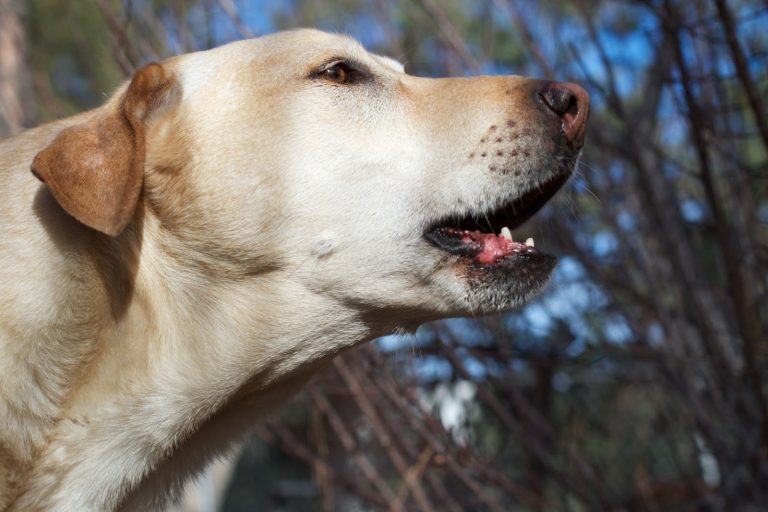
If you’re a Labrador owner or enthusiast, you’ve probably noticed how much these lovable dogs wag their tails. But did you know that their tail wagging behavior goes beyond just excitement and happiness? Understanding Labrador tail wagging is essential for comprehending their emotions and intentions. In this section, we’ll explore the significance of tail wagging in Labradors and how it serves as a means of communication.
Key Takeaways
- Labrador tail wagging behavior is a crucial aspect of their communication.
- Tail wagging can indicate a range of emotions and intentions.
- Understanding tail wagging enhances our ability to interpret our Labrador’s behavior.
- Labradors use their tails to communicate with humans and other animals.
- By paying attention to their tail wagging behavior, we can gain a deeper understanding of these lovable Labradors.
Decoding Labrador Tail Wagging
Labradors have a fascinating tail language that they use to communicate with humans and other animals. Understanding Labrador tail wagging is essential to decipher their emotions and intentions. In this section, we will examine the different tail positions, speeds, and accompanying body language to learn how to decode their messages.
Deciphering the Tail Positions
The tail position is the primary indicator of a labrador’s emotions. A high, vertical tail indicates confidence, dominance, or aggression, while a low tail is a sign of submission, fear, or nervousness. A tail held straight out behind the body shows alertness and focus, while a tail tucked between the legs indicates fear or anxiety.
It’s essential to understand that the tail’s position alone cannot provide a complete picture of the dog’s mood. You must also consider other body language cues like head tilt, ear position, facial expressions, and overall posture.
Decoding Tail Speeds
The speed of wagging is another critical component of the tail language that Labradors use. A wide, exaggerated wagging movement with the whole body indicates extreme happiness and excitement. A slower, more tentative wag could be a sign of nervousness or caution.
If the tail is wagging vigorously to the right, it usually indicates happiness and friendliness towards the recipient. Still, if it’s wagging more to the left, it could be a sign of uncertainty or potential aggression. However, this may not apply to every dog, so it’s essential to observe your dog’s specific behavior patterns.
The Role of Other Body Language
The tail language used by Labradors is not always enough to determine their mood. It’s why you must also observe their overall body language to fully understand their intentions.
The position of the ears, for instance, can provide insight into the dog’s emotions. Erect ears indicate attentiveness and curiosity, while flat ears show fear or submission. Additionally, eye contact, facial expressions, and overall posture are critical clues that can help you decode what your Labrador is trying to communicate.
By paying attention to the nuances of tail wagging and correlating them with other body language cues, you can gain a better understanding of your Labrador’s emotions and desires.
The Emotional Connection: Labradors’ Wagging Tails and Emotions
Labradors are known for their friendly and affectionate nature, and they often use their tails to express their emotions. As a Labrador owner, it is essential to understand the connection between their wagging tails and their emotional state.
Labradors use their entire body to communicate, and their tail is no exception. A wagging tail can indicate happiness, excitement, and eagerness to play. Conversely, a tucked tail can indicate fear, anxiety, or submission. Therefore, it is essential to pay attention to their body language and tail wagging behavior to gain insight into their emotional state.
Labrador body language and tail wagging often go hand in hand. For example, a wagging tail accompanied by perked ears and a relaxed body posture can indicate a friendly and approachable demeanor. On the other hand, a stiff body posture and a slow tail wag can indicate a tense or cautious emotional state.
Pro Tip: Pay attention to the speed of tail wagging. A slow and gentle wag can indicate a relaxed and content emotional state, while a fast and vigorous wag can indicate excitement or even aggression.
As a Labrador owner, it’s essential to understand the connection between their body language, tail wagging behavior, and emotions. By paying attention to these cues, you can improve your ability to connect with your Labrador and respond to their emotional needs effectively.
Labradors’ Wagging Tails and Emotions Guide
| Emotional state | Tail position | Tail wagging behavior |
|---|---|---|
| Happiness and excitement | Horizontal and straight | Fast and vigorous |
| Cautious or uncertain | Slightly lowered | Slow and nervous |
| Fear or anxiety | Tucked between legs | None or slow and nervous |
| Aggression or dominance | High and stiff | Fast and aggressive |
Understanding Labrador body language and tail wagging behavior can help you decipher their emotions and respond accordingly. By paying attention to their unique way of communicating, you can build a deeper bond with your Labrador and provide them with the emotional support they need.
Why Do Labradors Wag Their Tails?
Labradors are known for their enthusiastic tail wagging. But why do they wag their tails? There are several reasons for this behavior:
| Reason | Description |
|---|---|
| Communication | Labradors use their tails to communicate with humans and other animals. For example, a wagging tail may indicate friendliness, while a tucked tail may signal submission or fear. |
| Social Bonding | Tail wagging is also a way for Labradors to bond with their owners. When they wag their tails, they are showing affection and excitement. |
| Signaling Intentions | Labradors may also wag their tails to signal their intentions. For example, a fast wagging tail may indicate that they want to play, while a slow wag may suggest caution or uncertainty. |
Understanding why Labradors wag their tails can help you better interpret their behavior and strengthen your bond with your furry friend.
Labrador Tail Wagging Behavior as Communication
Labradors are known for their friendly and outgoing nature, and they often use tail wagging as a means of communication. Understanding their tail wagging behavior can provide insight into their intentions and emotions.
When a Labrador wags their tail, the position, speed, and accompanying body language can indicate the message they are trying to convey. For example, a high wagging tail with loose and relaxed body language may indicate a friendly greeting, whereas a rigid and fast tail wag may signify excitement or even aggression.
Labradors may also use tail wagging to express submission or appeasement. A low and slow wagging tail with lowered body posture may indicate a desire to avoid conflict or seek forgiveness.
Additionally, a curled-under tail may indicate fear or anxiety, while a tucked tail may indicate extreme fear or distress. Understanding these emotional cues can help you better communicate with your Labrador and create a more positive and supportive relationship.
Overall, tail wagging is just one aspect of Labrador communication, but it is a crucial one. By paying attention to their tail wagging behavior, you can gain insight into their emotions and intentions. Remember to consider tail wagging in combination with other cues, such as ear positions and overall body posture, to fully understand what your Labrador is trying to communicate.
Labradors and Their Wagging Tails: An Intricate Language
Labradors have a complex language that involves much more than just tail wagging. By observing their tail wagging behavior in conjunction with other cues, you can gain a deeper understanding of what your Labradors are trying to communicate.
Facial Expressions
Their facial expressions play a significant role in their communication. Labradors use their eyes to communicate a range of emotions, including affection, curiosity, and fear. Pay attention to their ears and mouth as well, as they can offer crucial insights into their mood.
Body Posture
Labradors’ body posture is another critical aspect of their communication. Their body language can indicate whether they are comfortable, nervous, or agitated. Pay attention to their overall posture, including their stance, level of relaxation, and any signs of tension.
Vocalizations
Labradors use a range of vocalizations to communicate, including barks, whines, and growls. Their vocalizations can indicate their emotional state, warn of danger, or express excitement. Understanding the tone and context of their vocalizations complements your interpretation of their tail wagging behavior.
| Labrador Communication Cues | Description |
|---|---|
| Eye Contact | Direct eye contact is an expression of affection, while avoiding eye contact may indicate discomfort or fear. |
| Body Posture | A relaxed and loose posture indicates comfort, while a tense posture usually signals anxiety or fear. |
| Vocalizations | Barking, whining, and growling can indicate a range of emotions, including fear, excitement, and warning signals. |
By taking a holistic approach to understanding Labrador communication, you can better interpret their wagging tails and respond to their needs. Remember, tail wagging is just one aspect of their intricate language. By observing and paying attention to their entire body language, you can deepen your connection with your lovable Labrador companions.
Conclusion
Labrador tail wagging behavior is a fascinating aspect of their communication. By understanding the significance of tail wagging in Labradors, we can decode their wagging language and gain insight into their emotions and intentions.
Deciphering Labrador tail wagging involves analyzing their tail positions, speeds, and accompanying body language. This, in turn, helps us understand the messages they convey through their wagging tails.
Labradors often use their wagging tails to express a wide range of emotions. Understanding these emotional cues helps us better connect with our furry companions and enhance our relationship with them.
Why do Labradors wag their tails? Tail wagging serves various purposes, including communication, social bonding, and signaling their intentions. By understanding the motivations behind tail wagging, we can better interpret our Labrador’s behavior and respond accordingly.
Labradors use their tails to communicate with humans and other animals. Their wagging behavior indicates friendliness, submission, playfulness or a warning signal. By paying attention to their tail wagging behavior and considering it in conjunction with other cues, we can better understand their intentions and emotions.
Labradors have a complex language that involves not just tail wagging but also other aspects of their body language, such as ear positions, facial expressions, and overall posture. By observing these cues holistically, we can gain a deeper understanding of what our Labradors are trying to communicate.
In conclusion, understanding Labrador tail wagging behavior and their language is essential for interpreting our furry companions’ emotions and intentions. By paying attention to their tail wagging behavior and considering it in conjunction with other cues, we can connect with them better and enhance our relationship with these lovable Labradors.
FAQ
What does it mean when a Labrador wags its tail?
Tail wagging in Labradors is typically a sign of happiness and excitement. It’s their way of showing positive emotions and greeting others.
Are there different types of tail wagging in Labradors?
Yes, Labradors can wag their tails in different ways to convey different messages. The speed, height, and position of the tail can indicate various emotions and intentions.
Can a Labrador wag its tail when it’s scared or anxious?
Yes, Labradors may also wag their tails when they are anxious or scared. It’s important to look at the overall body language and context to understand the true meaning behind the wagging.
Do Labradors wag their tails to communicate with humans?
Absolutely! Labradors use their tails as a way to communicate with humans and other animals. Tail wagging can express friendliness, playfulness, submission, or even serve as a warning signal.
Why do Labradors wag their tails?
Labradors wag their tails for various reasons. It can be a form of communication, a way to socialize and bond with others, or a means of signaling their intentions.
How can I interpret my Labrador’s tail wagging behavior?
To interpret your Labrador’s tail wagging behavior, it’s essential to consider the context, other body language cues, and the overall situation. Take into account the speed, height, and position of the tail, as well as any accompanying facial expressions or ear positions.
What other aspects of a Labrador’s body language should I pay attention to?
In addition to tail wagging, it’s crucial to observe a Labrador’s ear positions, facial expressions, and overall posture. These cues complement their tail wagging and provide a more comprehensive understanding of their communication.








